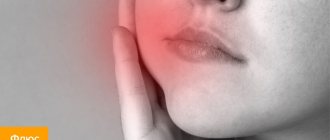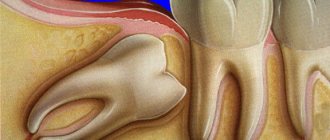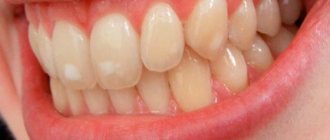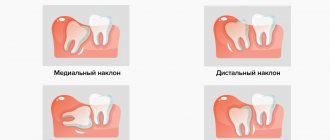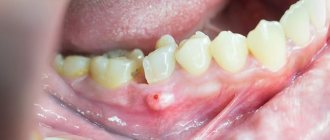Dental treatment
If the dentist does not treat the tooth correctly or completely, it can cause swelling in the cheek.
Causes:
- Allergic reaction.
It appears in the patient as a result of intolerance to the components of the filling. To eliminate swelling, you should visit a doctor and replace the installed filling with a hypoallergenic one.
- Removal of a tooth.
If the cheek is swollen after surgery, then the patient probably ignored the doctor’s recommendations and ate solid or hot foods.
- Nerve removal.
Swelling occurs if part of the nerve is not removed. It is important to see a dentist immediately so as not to lose a healthy tooth.
- Gum section.
Usually required to remove accumulated pus. If the swelling does not subside while taking anti-inflammatory drugs, this may be a serious symptom that requires the attention of a specialist.
Cheek swelling as a complication after tooth extraction
If a patient has had a tooth removed, then swelling is a natural phenomenon. However, it often indicates that the operation was performed incorrectly or the development of a pathological process due to the patient’s failure to comply with the recommendations in the postoperative period. To recognize the problem and contact a specialist in a timely manner, it is important to know that:
- Swelling is considered normal after removal of an upper wisdom tooth. In this case, the swelling spreads to the upper part of the face. Swelling of soft tissues is very natural, because the area where the tooth roots are located in this case also contains a large number of blood vessels of various sizes.
- Swelling is predictable after complex removal of lower wisdom teeth. If the problematic “eight” was sawed out or split and removed in parts, with a high degree of probability we can talk about subsequent swelling of the soft tissues of the face.
You can understand that swelling does not indicate pathology by the nature of the phenomenon. As a rule, it does not occur immediately after extraction, but the next morning. The swelling increases throughout the day, causing serious discomfort, and remains at the same level the entire next day. On the fourth day after tooth extraction, the swelling should subside and the discomfort caused by it should decrease. Against the background of “normal” edema, there is no fever or throbbing pain.
What to do if your cheek is swollen
To reduce swelling, you can use one of the following tips:
- Rinse your mouth with a solution of salt and soda.
This remedy has an antiseptic effect and helps destroy pathogens. You can enhance the effect by adding a couple of drops of iodine to the solution.
- Use chamomile infusion to rinse
, sage or other medicinal herbs that have anti-inflammatory properties.
- Apply a cold compress to the swollen cheek
if the swelling is caused by a bite or mechanical injury. This method is contraindicated in patients who have an elevated body temperature or a tumor that develops due to inflammatory processes. Warming compresses are not recommended.
- Lotions with aloe or Kalanchoe juice.
A cotton wool soaked in the juice of the plant is applied to the inside of the affected cheek.
If the described methods do not eliminate the problem, you should seek help from a doctor. The day before, you should not take painkillers and anti-inflammatory drugs, so as not to complicate the diagnosis.
Causes of periostitis
In addition to advanced caries, swelling of the cheek due to a tooth can be caused by other factors.
Inflammation of the gums
Periodontal disease can serve as a starting point for infection to penetrate the periodontal tissue. This diagnosis requires a thorough examination and often long-term treatment.Reaction to poor-quality canal filling
If depulpation is carried out without modern diagnostic equipment, the doctor may not completely clean the root canals. As a result, the remaining nerve tissue becomes inflamed and leads to such unpleasant complications as periostitis.
Inflammatory reaction to tooth extraction
Any tooth extraction is considered a minor surgical operation. It leaves an open wound that can become infected. In this case, the inflammatory process in the tissues occurs quickly and with complications in the periodontal tissue and periosteum.
Cyst formation in periodontal tissues
A tooth cyst can develop in a person over several years, and then at one point this process can spread to the periosteum tissue. If the spread of infection has gone so far, then the most likely option is to remove the diseased tooth, cleanse the affected tissues, and thoroughly treat all tissues with antiseptic drugs.
Infection due to injury
As a result of an open fracture of the jaw, pathogens can penetrate the tissues near the tooth, both soft and bone.
Infection through lymph nodes
In rare cases, the infection enters the periosteum through blood vessels or through inflamed tissue in the lymph nodes, such as with tonsillitis.
An indirect factor in the occurrence of periostitis may be concomitant diseases, decreased immunity, sore throat, acute respiratory infections, stress, etc. By the time a tooth hurts and a cheek swells, there is probably an accumulation of pus in the periodontal tissues. This process is quite dangerous for the body, as it can be accompanied by symptoms of acute inflammation:
- increased body temperature;
- general weakness, body fatigue;
- headaches, local pain in the area of inflamed tissue;
- formation of a purulent fistula with access to the oral cavity or through the soft tissue of the cheek;
- increased pain symptoms at night or when trying to chew.
If caries can be ignored, then with periostitis, patients simply “fly” to the dentist for help. The course of the disease can be so acute that there is no way to tolerate it. The specialists of the LeaderStom network of clinics have extensive experience in treating periostitis. With such a diagnosis, therapy is required not only for the tooth itself, but also for the entire body. Therefore, be prepared to follow all doctor’s orders, take antibacterial medications and regularly rinse your mouth every half hour.
If you have a toothache or a swollen cheek, it is recommended to immediately seek help from a dentist, but if this is temporarily unavailable, the following recommendations will help you cope with the pain.
- If your cheek is swollen and your tooth hurts, you should not apply warm compresses or bandages to your face, as heat promotes even greater inflammation of the dental tissues and can cause complications.
- A cold compress should be applied to the affected side of the face.
- Be sure to take a pain reliever.
- Rinse your mouth several times with infusion of chamomile, sage, and St. John's wort.
- It is strictly prohibited to take anti-inflammatory drugs and antibiotics without a diagnosis of “periostitis” and a doctor’s prescription.
Swelling of the cheek on the inside: what to do
How to remove swelling of the cheek? Depending on the degree of manifestation of the unpleasant symptom and the etiology, different treatment methods are used. Their success depends on the correct diagnosis.
When swelling occurs after dental implantation, ice should be applied to the sore cheek. You need to rinse your mouth lightly. It is important to maintain hygiene, diet and spare the postoperative wound.
Drug treatment
The doctor prescribes medications taking into account the clinical picture and the causes of swelling after a comprehensive diagnosis. You may need:
- "Miramistin" and "Chlorhexidine" - for rinsing;
- "Suprastin" is an antihistamine;
- "Nimesil" is an anti-inflammatory drug;
- “Amoxiclav”, “Lincomycin” are antibiotics that are prescribed for acute purulent periostitis.
How to relieve the pain accompanying the causative disease? Hexoral solution or spray or Lidocaine Asept aerosol can help. The painful syndrome in a child is relieved with the help of products that are used during teething, for example, Dentinox.
In some cases, conservative treatment is not enough, so surgical techniques are used. If there is suppuration, the doctor opens the gum, exposes the cavity with pus and installs drainage to drain the exudate. Surgery is also performed in the presence of a neoplasm.
Why does a white coating appear after extraction?
If white plaque appears after tooth extraction, this is normal. Dentists call it fibrinous plaque. It is the result of trauma and necrosis of the gums. No action needs to be taken. New cells that promote healing soon form under the necrotic tissue.
If the gums are swollen after tooth extraction, and soon loose white tissue appears, this is a sign of recovery. Doctors do not recommend removing the crust. It serves as protection for the injured area and usually resolves on its own.
What are the main treatments for cheek swelling?
The ATLANTIS DENTAL medical center has created ideal conditions for the diagnosis and treatment of dental diseases of any complexity. If you find that your cheek is swollen, you should urgently visit a doctor. Experienced therapists and surgeons will quickly and painlessly eliminate the problem, which will avoid unwanted complications.
- During the consultation, the doctor collects anamnesis, performs a dental examination, and prescribes diagnostic measures (x-rays, CT scans, blood tests, etc.).
- If necessary, the patient is referred for consultation to specialized specialists: neurologist, otolaryngologist, endocrinologist, etc.
- Based on the results of the examination, a treatment regimen is determined.
- When cystic neoplasms, pulpitis and inflammation of the periosteum are detected, surgical intervention is necessary.
- It may also be necessary to remove the tooth or refill the canals.
Good results are shown by treatment with antibacterial drugs, rinsing the mouth with antiseptics and applying dental gels to the affected areas.
When to see a doctor
If you have followed all the rules, carried out all the procedures aimed at reducing swelling, and your condition continues to worsen, then this is a sure sign that you need to urgently consult a dentist. Immediate medical attention is required if:
- the next day the swelling increased, and the pain did not decrease;
- the temperature has risen, general health has worsened;
- opening the mouth is accompanied by painful sensations, and the smell of rotting from the hole is felt.
All these symptoms should prompt an immediate visit to the dentist to avoid serious consequences.
Flux symptoms
Clinical manifestations of acute periodontitis/periostitis are quite characteristic. Flux manifests itself as sharp pain in the tooth area, intensifying even with light pressure on it. Swelling and redness of the lips, cheeks, enlarged gums, and the tooth is often mobile.
There is an unpleasant odor from the mouth, and sometimes fistulas on the gums. A characteristic sign of gumboil is the appearance of independent pain, weak at first, then intensifying, becoming pulsating and tearing. Its difference from pain with pulpitis is that it is strictly localized and becomes sharp when pressing on the diseased tooth, especially in the form of tapping. The closing of teeth is so painful that many people refuse to eat even liquid food.
Clinical manifestations of acute periodontitis/periostitis are quite characteristic. Flux manifests itself as sharp pain in the tooth area, intensifying even with light pressure on it. Swelling and redness of the lips, cheeks, enlarged gums, and the tooth is often mobile.
There is an unpleasant odor from the mouth, and sometimes fistulas on the gums. A characteristic sign of gumboil is the appearance of independent pain, weak at first, then intensifying, becoming pulsating and tearing. Its difference from pain with pulpitis is that it is strictly localized and becomes sharp when pressing on the diseased tooth, especially in the form of tapping. The closing of teeth is so painful that many people refuse to eat even liquid food.
It is also possible to increase body temperature to 37.5-38.0°C. Severe pain and difficulty eating food force the patient to see a dentist within the next few hours from the moment of illness.
Chronic form of periodontitis
In chronic forms of periodontitis, a different picture is observed. The most formidable and insidious in its course and possible complications is chronic granulating periodontitis and exacerbation of its course. The pain reaction is mild, but often in the vestibule of the oral cavity, in the projection of the apex of the root of the affected tooth, a fistula periodically opens with small purulent discharge.
When the fistula is closed during periostitis, swelling and hyperemia of the mucous membrane in the area of the flux and pain when pressing on the diseased tooth are possible. Chronic granulating periodontitis is diagnosed based on a comparison of clinical manifestations with X-ray data, which shows destruction of the periodontal gap and changes in the jaw bone in the form of “tongues of flame” in the area of the apex of the tooth root. The purulent process in the medullary spaces of the jaw adjacent to the periodontium leads to the spread of infection over a considerable distance.
The vital activity of pathogenic microflora during the long-term existence of a chronic pathogenic focus ultimately leads to odontogenic chronic sepsis. This provokes the emergence, formation or exacerbation of chronic infectious diseases of the heart, liver, kidneys and other organs.
The presence of such infectious foci can dangerously affect the course of pregnancy at any stage; complications such as infection of the female genital area, miscarriage, and disruption of the formation of fetal tissue occur.
Main rules after surgery
Do not touch the wound
. After the operation has been performed, the body does most of the work itself, so it rarely requires outside intervention.
After removal, a blood clot forms at the wound site. It is very important to keep it in place, so you should take extra care when eating and other activities that involve the oral cavity. Main restrictions
.
You should not consume food or liquid for 4 hours after the procedure. For several days after the operation, it is important to be careful when eating, avoid alcohol and smoking, and do not eat too spicy, sweet or salty foods. It is also very important to maintain a comfortable temperature and not drink or eat anything too hot or cold. Compress
: Swelling of the cheek and gums is significantly reduced if applied to the cheek for a few minutes every half hour.
This convenient and simple remedy helps not only relieve swelling, but also relieve pain. It only helps during the first three days. In the following days, this translates into contraindications. Following the recommendations of a specialist
. If the doctor recommended certain medications, then you need to take them only in the prescribed amount and when the doctor said. There is no need to self-medicate.
Tumor as a sign of complications
The most common cause of deterioration occurs due to improper care of the formed hole. If the clot is broken and an infection has entered, then this can lead to swelling of the cheeks and gums, so you should definitely make an appointment with the dentist so that he can quickly solve this problem. You should consult a doctor if:
- constantly increasing throbbing pain;
- temperature is above 38 and does not go away for several days;
- when the jaw moves, the pain intensifies;
- The tumor is constantly growing and there is swelling.
At the appointment, the doctor will clean the hole and treat it with an antiseptic. In some cases, repeat surgery and antibiotic therapy may be required.


